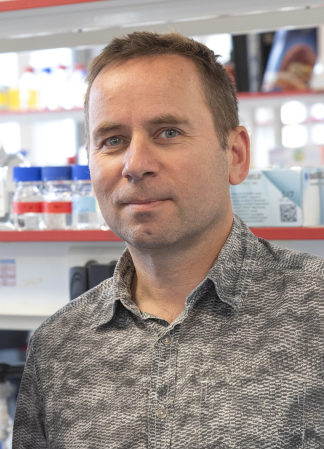 In August 2023, Bruno Cadot won a call for proposals organised by the German National Innovation Fund (SPRIN-D) to finance his innovative project to create a synthetic muscle, combining chemistry and biology. Now that proof of concept has been achieved in mice, the next step is to make the transition to human transplants. Interview with Bruno Cadot.
In August 2023, Bruno Cadot won a call for proposals organised by the German National Innovation Fund (SPRIN-D) to finance his innovative project to create a synthetic muscle, combining chemistry and biology. Now that proof of concept has been achieved in mice, the next step is to make the transition to human transplants. Interview with Bruno Cadot.
What is the background to this project?
I’ve been in contact for several years with two chemist colleagues, Léa Trichet* and Francisco M. Fernandes*, who have succeeded in chemically designing a collagen structure that closely resembles muscle. We wanted to set up a project based on the idea of using it as a support for muscle cells. When SPRIN-D launched its call for tenders, we decided to respond. Two months later, our project was accepted.
Why did you want to create a muscle organoid?
Muscle is difficult to transplant in humans, apart from the heart and muscle allografts, which are very complicated surgical procedures. It would therefore be useful to be able to synthesise a muscle that could be used directly for transplantation. It has already been realised in mice, and transplanted animals recover functional muscle within three weeks.
What are the different phases of the project?
The entire project will take 8 months to achieve. The organoid will be formed from an artificial collagen structure that resembles muscle extracellular matrix, and human cells that can anchor and develop within it. The next stage will involve grafting the tissue obtained into a human and then functionally evaluating it.
Will other teams from the Institute of Myology be involved?
Researchers and research engineers from several teams at the Institute of Myology (Benjamin Marty, Antoine Muchir, Capucine Trollet & Vincent Mouly) will be involved in the stages of forming the organoid, then grafting it onto mice and assessing the presence and effective reconstruction of the grafted muscle.
What are the next steps before moving on to humans?
We need to check with experts that the transplant is feasible. I’m already attempting to contact surgeons specialising in tissue reconstruction to get their opinion, and to see if they would be prepared to support us in a clinical trial. We could imagine transplanting our organoid into people who have suffered muscular injuries following an accident or the removal of a tumour, for example.
And to push things even further, just as we know how to make bone or blood vessels and will soon be able to make muscle, perhaps will this be the end of amputation?
________
* Léa Trichet and Francisco M. Fernandes in the Laboratoire de chimie de la matière condensée de Paris at Sorbonne Université.
